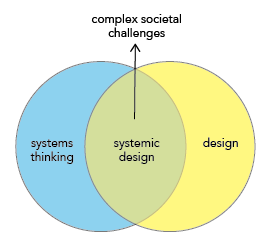Over the past decades, design has moved from a practice aimed at designing things, to one that contributes to addressing today’s complex societal challenges. One of the ways in which design is adapting to the domain of complex societal challenges is the way in which its practices have evolved to become increasingly systemic. This includes designers building a deep understanding of the complexity and wickedness of problems and societal systems, as well as the development of new practices to design for these systems. Many of these scholars have argued how design practices can be enriched through systems thinking theories and practices. The field that bridges design and systems thinking is often called ‘systemic design’ (Sevaldson and Jones 2019). The focus of systems and complexity thinking traditionally has been on analysing and understanding the behaviour of societal phenomena through a complex systems lens. Design practice has been recognised as an opportunity to not just analyse such systems, but also design for or intervene in such systems to achieve positive societal impact (Ackoff 2004, Banathy 1996). For an elaborate explanation of what systemic design is and is not, see this blog post on Medium.
Systemic design is a field that is quickly growing. Many design schools have started to adopt strategies focused on systemic design education, including our own faculty of Industrial Design Engineering at TU Delft. In addition, many design professionals have started to adopt systems and complexity perspectives in their work, in a response to increasing work opportunities in the public and social sector to tackle complex societal challenges. As a consequence, there is high demand for knowledge that spans design and systems thinking towards tackling societal challenges.
Research in Systemic Design
My research interest is to investigate methods and practices to tackle complex societal challenges that build on design practice and design expertise, as well as on a vast and growing body of knowledge in systems and complexity thinking. A growing group of scholars and practitioners within the emerging field of systemic design has been experimenting with integrating systems thinking and design. Within these ‘experiments’, we can distinguish two main groups of approaches:
- The first approach is focused on co-creation and co-designing from within organisations or networks that are seen as complex social systems (Carvalho and Goodyear 2017, Junginger 2015, Vink et al. 2021). In this context, ‘everybody is a designer’ (Manzini 2015), and expert designers’ roles are described as facilitating and staging this collective design process.
- The second group of methods focuses on building a complex and systemic understanding and visualisation of challenges and the systems from which they emerge, that can then subsequently be used to ‘inform’ the design of interventions (e.g. system mapping (Sevaldson and Jones 2019), reflexive methods (Vink et al. 2021), and social network analysis (Baek et al. 2018)).
While both groups of methods and approaches are important, there have so far been limited studies on the integration of design expertise and systems and complexity thinking. The latter group of methods approaches design in a linear way from a systemic analysis of a challenge to informing the design of interventions. However, we know that design expertise is not just a matter of a linear approach from problem identification to ‘informing’ solutioning, but that it involves sophisticated design reasoning in a process of co-evolution of ‘problem and solution’. What if we bring design expertise and complexity thinking closer together? How can design experts use systems and complexity thinking to design interventions that have positive impact on complex contexts?
Systemic design principles
In this article, I worked with Bridget Malcolm to identify five ‘systemic design principles’ in social innovation practices. This list is not a ‘complete’ list of principles. Rather it is an attempt to show how both fields of study and practice can strengthen each other. The five principles are:
- systemic perspective taking: to recognise that challenges are interrelated and emerge from complex contexts and to acknowledge the limitations of reductionist thinking
- empathy with the system: to complement an investigation of people’s needs and aspirations with an investigation of relationships and tensions between people
- designing for human relationships: to use human relationships as a leverage point for change by enabling relational qualities such as creativity, learning, care, and motivation
- designing for mental models: to explore beliefs and mindsets required to enable change and to design interventions for experiences that challenge mental models
- an evolutionary design approach: to continuously design interventions and safe-to-fail experiments in complex contexts to enable co-evolution of interventions and context, see also this open access article.
References
Ackoff, Russell L. 2004. “Transforming the systems movement.” https://thesystemsthinker.com/transforming-the-systems-movement/.
Baek, Joon Sang, Sojung Kim, Yoonyee Pahk, and Ezio Manzini. 2018. “A sociotechnical framework for the design of collaborative services.” Design Studies 55:54-78.
Banathy, Bela H. 1996. Designing social systems in a changing world. New York: Plenum Press.
Carvalho, Lucila, and Peter Goodyear. 2017. “Design, learning networks and social innovation.” Design Studies 55 (2015):27-53.
Junginger, Sabine. 2015. “Organizational Design Legacies and Service Design.” The Design Journal 18 (2):209-226.
Sevaldson, Birger, and Peter Jones. 2019. “An Interdiscipline Emerges: Pathways to Systemic Design.” She ji: The Journal of Design, Economics and Innovation 5 (2):75-84.
van der Bijl – Brouwer, Mieke, and Bridget Malcolm. 2020. “Systemic Design Principles in Social Innovation – a Study of Expert Practices and Design Rationales.” She ji – The Journal of Design, Economics and Innovation 6 (3):386-407.
van der Bijl – Brouwer, Mieke, Giedre Kligyte & Tyler Key. 2021. “A Co-evolutionary, Transdisciplinary Approach to Innovation in Complex Contexts: Improving University Well-Being, a Case Study.” She ji – The Journal of Design, Economics and Innovation 7 (4):565-588.
Vink, Josina, Kaisa Koskela-Huotori, Bård Tronvoli, Bo Edvardsson, and Katarina Wetter-Edman. 2021. “Service Ecosystem Design: Propositions, Process Model, and Future Research Agenda.” Journal of Service Research 24 (2).
